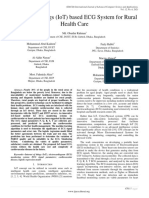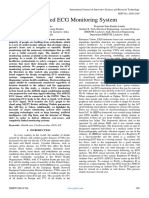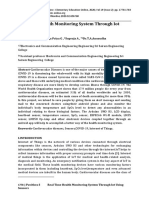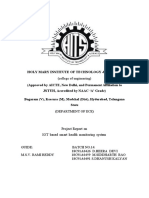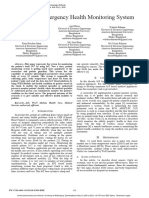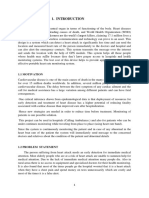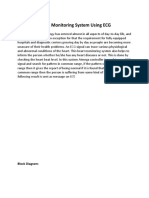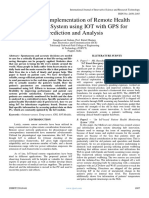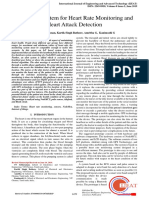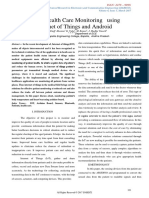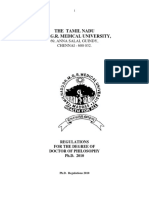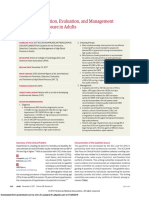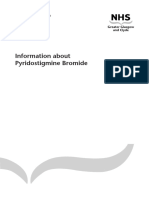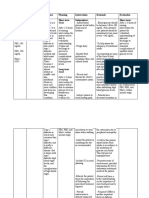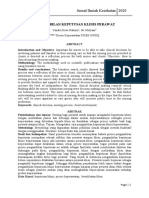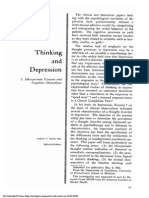International Journal of Advanced Innovative Technology in Engineering (IJAITE),
Vol.6, No.4, July 2021
E-ISSN: 2455-6491
Available online at www.ijaite.co.in
Heart Defect Monitoring System Using ECG
1
Ansar Sheikh, 2Kalyani Raghuwanshi, 3Komal Mahulkar, 4Madhuri Dasariya, 5Avshali Nagpure
person has a cardiac condition.
Abstract— In India's rural areas, about 40 percent of the In order to model a heart rate monitoring system,
population lives in poverty. Furthermore, due to a lack of you'll need a heart rate sensor, a Wi-Fi module, and an
sophisticated healthcare-related technologies, rural residents' Arduino. The alarm message is obtained by combining IoT
access to nursing and diagnostic services is limited. As a with this through a heart rate applies if a heart attack happens.
result, rural residents are denied access to adequate The sensor's data is obtained by sensing the intensity of
healthcare. In this light, current technology can aid in the light. The sensor's data is analyzed in a hub before being
alleviation of their health problems. The human chest is transferred to the software display unit. The sensor records
interfaced with ECG sensing equipment, and the necessary the human's physiological data. The management unit can be
cardiovascular data is acquired via an IoT device. These files used in conjunction with a local host network IoT system.
are saved in the cloud and are accessible via MQTT and The results are shown on a monitor, a smartphone, or a
HTTP servers. This paper proposes a novel IoT-based
laptop. Arduino UNO, pulse sensor, and LEDs make up the
solution for ECG monitoring systems on cardiovascular or
hardware system. The physician can use the cloud platform to
heart patients. P, Q, R, S, and T are ECG signal parameters
diagnose patients in faraway areas with this method such as
that are gathered, preprocessed, and forecasted to monitor
cardiovascular problems for future health management. The the home.
relevance of ECG signal characteristics and error rate is Patients can also use this cloud service to view their
determined using a machine learning system. The logistic medical records. Various types of ECG recorders are
regression model suited the train and test data with the best available on the market from reputable companies, however,
agreement. The prediction was made to see how PQRST there are currently relatively few devices that can record ECG
quality varies and how well it fits into the ECG Monitoring signals and transmit them to a remote database server on the
System. When the values of quality factors are taken into cloud. In this study, we suggest a system that uses a sensor to
account, satisfactory outcomes are attained. In the future, the record ECG signals from patients and then stores the signals
suggested IoT-based ECG system minimizes the cost of on a database server. These signals can be analyzed remotely
health care and the complexity of cardiovascular disorders. by a clinician, or they can be saved and retrieved for study
later. Because traditional ECG monitors only assess the
Keywords: Internet of things (IoT), Electrocardiogram electrical activity of the heart for a brief period of time,
(ECG) Monitoring System, ECG Signal Parameters, there's a good chance that heart-related disorders aren't
Cardiovascular Disease present at that time.
I. INTRODUCTION The features of the system are below:
Embedded technology has pervaded practically every part
of daily life, and the healthcare industry is no exception. As • It will be a useful tool because it presents all of the data and
people become more conscious of their health problems, the information that has been gathered just from the internet. As a
need for fully-equipped hospitals and diagnostic centers is result, the patient's family who work outside the home
expanding. This is accomplished by measuring the heart rate. experience less stress and anxiety.
In this system, an Atmega controller is used to scan the ECG • Being connected to the health care system via IoT allows
signal and look for patterns in the common range; if the doctors to improve diagnostic accuracy by having all
pattern is found to be in the common range, the individual is important patient data at their fingertips. In a nutshell, it
healthy; if it is not found to be in the common range, the enables remote and continuous patient monitoring.
• Doctors and family members can work without fear
Manuscript received June 5, 2021; Revised 25 June, 2021 and Published because they can monitor the patient's health from anywhere.
on July 31, 2021 It also sends out alarms whenever a specific health parameter
Prof. Ansar Sheikh, Assistant Professor Department of Computer Science exceeds the recommended limit. Furthermore, receiving a
and Engineering, Suryodaya College of Engineering, Nagpur, Maharashtra, warning allows doctors and family members to take proper
India. action, perhaps saving lives in an emergency.
Kalyani Raghuwanshi et. al., Students Department of Computer Science • Most elderly individuals prefer to stay at home with their
and Engineering, Suryodaya College of Engineering, Nagpur, Maharashtra, loved ones rather than visiting or spending time in hospitals.
India. People, on the other hand, develop a range of diseases as a
. result of their stressful lifestyles and grow frail as they age.
Furthermore, ICU patients will benefit from this initiative.
113
� International Journal of Advanced Innovative Technology in Engineering (IJAITE),
Vol.6, No.4, July 2021
E-ISSN: 2455-6491
Available online at www.ijaite.co.in
II. PROPOSED WORK/METHODOLOGY
Figure 2. Design of the IOT Device-based ECG System
Figure 1: Arduino with Heart Rate Monitor
III. SYSTEM ARCHITECTURE
A Remote Health Monitoring System consists of three
main components such as data sensing module, the data The IoT Technology is used in the Heart Disease
processing module, and the data communication module. The Monitoring System. Signals, ATmega3285p Microcontroller,
data sensing module consists of a temperature sensor and AD832 ECG Senser, Heart rate sensor, IR Sensor, and LCD
heartbeat sensor which senses the changes in the respective Screen are some of the important components in the system
physiological parameters. The information is transferred to architecture. ECG Sensor AD8232: To complete the project,
the microcontroller of the data processing module. The data an Arduino Mega 2560 microcontroller board is used. The
processing module analyzes the input signals. The noise board features a 16 MHz crystal oscillator, 54 digital
signals are filtered and if the processed value exceeds than input/output pins, four UARTs, sixteen analog inputs, a USB
normal value, medicine which is to be given as first aid for connection, an ICSP header, a power jack, and a reset button.
the patient is displayed on the personal computer using GUI. The ATmega2560 board is powered by a USB connection or
The communication module is used to transfer data between a power supply. The energy source is chosen automatically.
person and equipment. This has basic components such as the There are two power adapters in use. One is a 9-volt battery,
message, the sender, the receiver, the medium, and the while the other is a 5-volt laptop USB charger.
protocol by which the message is sent to the doctor through Those power sources provide 3.3v to heartbeat, ECG, and
mobile phones by an information gateway for the treatment to Wi-Fi sensors. The sensors may be damaged if additional
be taken. power is applied to them. Registers are used to reduce the
source voltage and protect the system from damage. The
central control unit of the system is Arduino. On the input
A. Block Diagram side, there is a heartbeat sensor, an ECG sensor, and
In the block diagram, an ECG signal can be used to track numerous manual buttons. The output is displayed on the
various physiological and pathological heart states. This Arduino com port.
cardiac monitoring equipment also assists in determining
whether or not a person has any heart issues. This is
A. ECG Sensors
accomplished by measuring the heart rate. In this system, an
Atmega controller is used to scan ECG signals and look for Arduino pins 10 and 11 are used to initialize LO+ and LO-.
patterns in a common range; if the pattern is determined to be Additional controls are set to A0 in pin OUTPUT, GND in
in the normal range, the individual is healthy; if it is not in the pin GND, and 3.3v in pin 3.3v. At first, the ECG and
usual range, the person has a cardiac condition. On the Heartbeat measurements are both zero. The Wi-Fi Module
Internet of Things, the following result is provided as an alert enables data to be transferred to the cloud, and once the data
message. has been uploaded, the results can be viewed by logging into
the server with a computer.
B. Wi-Fi model
An auto-configuration technique is included in the Wi-Fi
cloud module. RX and TX of the Wi-Fi modules are
initialized on Arduino pins 9 and 8, while CH EN and VCC
are linked to Arduino pin 3.3v. The application is uploaded to
the Wi-Fi module using another pin called GPIO 0. Initially,
two distinct sensors are combined, and two different
programs are started concurrently, with the output result
being sent to the Arduino's COM3 port. The hardware is used
115
� International Journal of Advanced Innovative Technology in Engineering (IJAITE),
Vol.6, No.4, July 2021
E-ISSN: 2455-6491
Available online at www.ijaite.co.in
to read the heartbeat in the heartbeat approach. For the first provide a variety of closer glances at heart activity.
20 seconds, the heartbeat is counted. The value is determined Furthermore, if at least three ECG sensors are put in
when the heart bit pin lifts to its highest position. The appropriate areas on the body, measurements from several
heartbeat is approximated for 60 seconds or 1 minute while ECG sensors taken at the same time can provide redundancy
data is being collected. Finally, the data from the heartbeat is and even synthesis of the standard ECG. When the heart rate
uploaded to the cloud. The ECG technique uses the same per BPM (Beats per minute) is >40 and 60, the low pulse rate
command line as the heartbeat method. Count the ECGs and is indicated. Low heart rate can lead to medical issues,
send analog or digital data if the count is fewer than 50. indicating that the patient requires medical assistance to
maintain a normal heart rate. The typical pulse rate varies
from >60 to 100, indicating that the patient's pulse rate is
C. Lead ECG Electrode
within the normal range with no complications. The high
A three-lead arrangement is sufficient to capture the ECG heartbeat is between>100 and<150 which indicates the
signal's major properties. The electrodes must be arranged in patient has a high pulse range that could result in
a triangle around the heart in order to best collect the ECG heart-related diseases. With actual heartbeat rates, the
data. Figure 6 depicts the 3-lead configuration used in our experimental results showed an acceptable range. Finally, for
system. For the goal of confirming the reliability and the end-user, this handheld system has shown to be a valuable
accuracy of the proposed system, several experiments are heart rate counting and heart attack detection system.
done on a healthy volunteer using the 3-lead implantation.
ACKNOWLEDGEMENT
IV. IMPLEMENTATION
It is very helpful for the Support and help our Guide Prof.
Ansar Sheikh and other staff of Computer Engineering
Department of Suryodaya College of Engineering.
They have helped us during every aspect of this project and
gave us a platform to showcase our skills and dedication
through this project.
REFERENCES
[1] Shikha, E. Sriranjini, Manju Jose, Dr. Sasi Kala Rani, “IoT based Heart
defect monitoring system using ecg” International Journal of Advanced
Research, Ideas, and Innovations in Technology, Volume 4, Issue 2.
pp-2026- 2031.
[2] Rajashree, Radha BK. “Real-Time Ambulatory Monitoring System”
Figure 3: Heart beat rate International Research Journal of Engineering and Technology.
Volume: 04 Issue: 05, May -2017, pp 605-611.
[3] Nikunj Patel, Prince, Kumar Patel, Nehal Patel “Heart Attack
V. BENEFITS Detection and Heart Rate Monitoring using IoT” International Journal
of Innovations and Advancements in Computer Science, IJIACS,
Volume 7, Issue 4, pp 612- 615.
1) This system uses IOT to create a heart defect monitoring
[4] Neramitr Chirakanphaisarn, Thdsanee Thongkanluang, Yuwathida
system that uses ECG. Chiwpreechar “Heart rate measurement and electrical pulse signal
analysis of subjects span of 20-80 years” Journal of Electrical Systems
2) By offering real-time heart health monitoring, the and Information Technology 5 (2018) pp-112-120.
proposed design benefits patients of various ages. [5] Duaa Elsayed Idris Babiker. “Arduino Based Heart Rate Monitoring
and Heart Attack Detection System” The University of Khartoum.
Index no.124046. October 2107.
3) It also ensures the patient's data is secure and private. [6] Bandana Mallik, Ajit Kumar Patro “Heart Rate Monitoring using
Finger Tip through Arduino and Processing Software” International
Journal of Science, Engineering and Technology Research, Volume 5,
4) The proposed design is implemented as a real-time Issue 1, January 2016, pp- 84-89.
monitoring system that uses MQTT and IFTTT protocols to [7] Nusrat Jahan Farin, S.M.A Sharif, Iftekharul Mobin “An Intelligent
provide prompt health treatment to the patient. Other sensor-based system using Real Time Heart Rate Monitoring (HRM)”
elements of the design include an alarm system and location Intelligent Control and Automation, Vol.7, 26 May 2016, pp-55-62.
monitoring. [8] Prof. Vivekanand P. Thakare, Ms. Rushali Deshmukh, Ms. Nikita
Dayare, Ms. Punam Ankatwar, Mr. Jayendra Uprade, “Ear Based
Biometrics Detection And Identification”, IJARIIE, Vol-6 Issue-3,
VI. CONCLUSION March 2020, Page No. 248-255,ISSN (O): -2395-4396.
We also provide our experience with the technical aspects of
sensor creation, as well as our experience with experimental
and practical measurements with the ECG sensor, in this
project. Despite the fact that a wearable ECG body sensor
contains less information than a typical 12-lead ECG, it can
115
